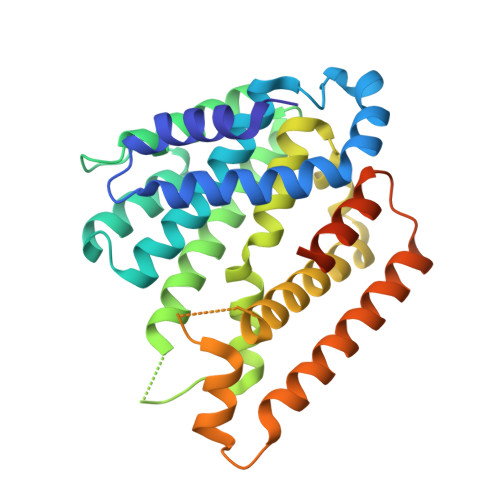Structure, function and inhibition of ent-kaurene synthase from Bradyrhizobium japonicum.
Liu, W., Feng, X., Zheng, Y., Huang, C.H., Nakano, C., Hoshino, T., Bogue, S., Ko, T.P., Chen, C.C., Cui, Y., Li, J., Wang, I., Hsu, S.T., Oldfield, E., Guo, R.T.(2014) Sci Rep 4: 6214
- PubMed: 25269599
- DOI: https://doi.org/10.1038/srep06214
- Primary Citation of Related Structures:
4W4R, 4W4S, 4XLX, 4XLY - PubMed Abstract:
We report the first X-ray crystal structure of ent-kaur-16-ene synthase from Bradyrhizobium japonicum, together with the results of a site-directed mutagenesis investigation into catalytic activity. The structure is very similar to that of the α domains of modern plant terpene cyclases, a result that is of interest since it has been proposed that many plant terpene cyclases may have arisen from bacterial diterpene cyclases. The ent-copalyl diphosphate substrate binds to a hydrophobic pocket near a cluster of Asp and Arg residues that are essential for catalysis, with the carbocations formed on ionization being protected by Leu, Tyr and Phe residues. A bisphosphonate inhibitor binds to the same site. In the kaurene synthase from the moss Physcomitrella patens, 16-α-hydroxy-ent-kaurane as well as kaurene are produced since Leu and Tyr in the P. patens kaurene synthase active site are replaced by smaller residues enabling carbocation quenching by water. Overall, the results represent the first structure determination of a bacterial diterpene cyclase, providing insights into catalytic activity, as well as structural comparisons with diverse terpene synthases and cyclases which clearly separate the terpene cyclases from other terpene synthases having highly α-helical structures.
Organizational Affiliation:
1] Industrial Enzymes National Engineering Laboratory, Tianjin Institute of Industrial Biotechnology, Chinese Academy of Sciences, Tianjin 300308, China [2].















